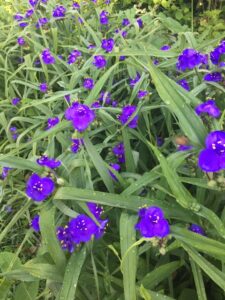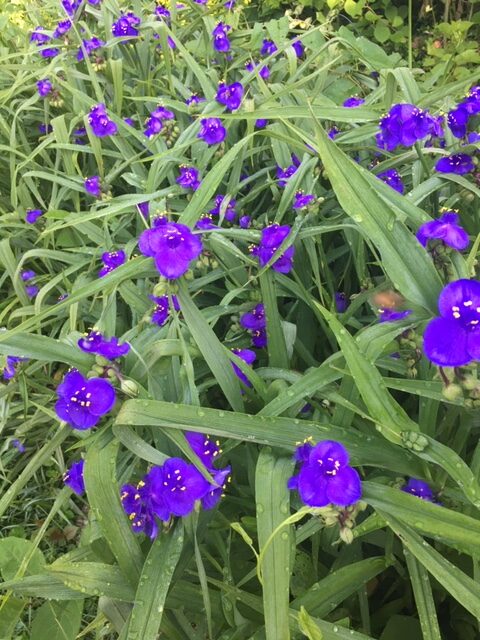June 7th
The 158th Day of the Year
O for boyhood’s time of June
Crowding years in one brief moon,
When all things I heard or saw,
Me, their master, waited for.
John Greenleaf Whittier
Sunrise/set: 5:07/8:01
Day’s Length: 14 hours 54 minutes
Average High/Low: 80/58
Average Temperature: 69
Record High: 95 – 1933
Record Low: 43 – 1910
Weather
Skies are overcast more often on the 7th than on any other day of the month (55 percent of the time). Rain, however, comes an average of just one year in three. Temperatures are almost always above 70. There is a 15 percent chance of heat in the 90s, forty-five percent for a high in the 80s, thirty-five percent of 70s, five percent of 60s.
Natural Calendar
The breakdown of Late Spring becomes more apparent as poppies, columbines, pyrethrums, lupines, peonies, iris and sweet rockets disappear. Strawberries are thinning as black raspberries start their season. The darkening of the golden winter wheat measures the steady advance of Early Summer.
Oaks, Osage orange, locust and black walnut trees have set their fruit. There are bud clusters on the milkweeds, buds on the delicate touch-me-nots, buds on the giant blue hosta, buds on the yucca and purple coneflowers, the mallow, the early daylilies, balloon flower and gay feather. Catchweed and chickweed die back, exhausted and matted. Watercress is pale, has turned underside up. May apple foliage is yellowing. Jack-in-the-pulpits are wilting. Brown seeds drop from the small-flowered crowfoot. All the last, fragrant mock orange petals have scattered in the wind.
Daybook
1981: Fireflies began tonight.
1982: Squirrels are half grown, eating the new mulberries. Firefly season started tonight.
1984: First Canadian thistle seen in bloom today. Siberian iris completely gone (after just five days of flowering). Most locust flowers gone, peonies starting to wilt.
1985: Parsnip and angelica to seed, and first buds on the milkweed. Tall meadow rue blooming.
1986: Burdock ready to flower. Moth mullein common and full. Pokeweed in the yard is seven feet tall and has small flower buds. First tropical storm of the year forming in the Caribbean. For several days now, flocks of gold finches seen along Wilberforce Clifton Road and at South Glen.
1987: First black raspberry eaten, last quart of strawberries picked. Squirrels and groundhogs noticed half grown. White waterleaf still late bloom. Walked by the Mill at nine o’clock this evening: the field crickets were strong, frogs chanting. For the first time, mosquitoes were bothersome. Fireflies were common.
1988: Drought throughout Ohio and the Midwest is causing serious crop damage. Last poppies are blooming. Chicory opens in town. Daisies fading in the south garden. First raspberry eaten. Winter wheat turning more now; it pales at first, then becomes lighter and lighter green, then yellow, tan, gold, brown. Roadside smooth brome darkening, ripening like the wheat. Mock orange gone at home, still blooming in the Glen parking lot. No fireflies yet.
1990: Fishing at Caesar Creek, old fishing hole: one catfish, two perch, four carp in an hour and a half, mid to late afternoon, second quarter of the moon, muggy and hot. Frogs were loud, fish jumping everywhere. Carp sloshing along the shores. The catfish had been eating crayfish. On way home: wheat turning, mock orange almost gone.
1991: To Madison, Wisconsin: Yellow sweet clover the dominant flower throughout the whole trip. Crown vetch also full. Some bright purple cow vetch, yarrow, spiderwort. Peonies still late bloom in Wisconsin, mock orange full-flowered. Parsnips seen at the same level in both Madison and Yellow Springs. Chicory and meadow goat’s beard in bloom most of the 500 miles north.
1992: Returning to Yellow Springs after a week in Wisconsin: peonies, all iris, ranunculus, sweet rocket almost gone. Pyrethrum cut back, roses and daisies full. First red-orange lychnis blooming, and coreopsis fully budded. Gay feather and evening primrose budded. Gray aphids take over the old rocket stems. Cucumber beetles and new red and black beetles eating mums. Astilbe color shows, but not in bloom. Lilies budding. Strawberries coming in, spinach going to seed, tomatoes a foot and a half high.
1993: The violet clematis is glowing in the sun, full bloom. More and more Siberian iris wither. Lupine holds late. Osage, mock orange flowers still falling. Peonies suddenly shriveling in the yard. Buds on the sweet peas, tiger lilies, hollyhocks, and south garden coneflowers.
1996: The rains continue, flooding and standing water everywhere. More than half the corn has still not been planted. East of the Mississippi, the crop will be light because of delays in seeding. In the West, dramatic drought. Here in the east garden the columbines are thinning as the astilbe reddens. In the north garden, the Siberian iris is dropping now, and the first garlic plants are starting to head up (down on Elm Street, wild garlic has had full tall heads for several days). In the west garden, the pyrethrums have passed their prime. Daisies have been beaten down by the rain; they are also fading. Sweet rockets have almost all gone to seed. First lamb’s ear is flowering. This evening, the first primrose came into bloom.
1997: The cool spring continues: Siberian iris holding, sweet Williams approaching their peak. Daylilies budding in Xenia. Rockets are still late full. Daisies full. Pyrethrum past prime, but still all right. Spiderwort fat and lush this year. Pale columbine almost all gone. Mock orange holds at full, some petals falling. Peonies in the yard full and firm. Now the spinach is at its peak, radishes too.
1998: Baby robin on the front sidewalk, the second this week. Yellow swallowtails are coming to the garden regularly now.
1999: Zinnias planted. Loud crows and cardinals, full morning song at 4:45 a.m. First helianthus blooms in the south garden, totally full primrose.
2004: Santee Cooper, South Carolina to Yellow Springs: Red periodic cicadas were loud from 50 miles south of Cincinnati to about halfway to Dayton.
2005: The first purple coneflower and evening primrose opened today. Chicory seen in bloom.
2006: The Japanese pond iris was open this morning. Evening primrose is now in full bloom, along with the sweet William, lollipop lilies, lamb’s ear. Throughout the village, pink spirea is common, but our bush is still only budding.
2007: Japanese pond iris continues full bloom. Some grackle babies still being fed in the lawn. Many purple coneflowers now in bloom. First “green-eyed” Susan unravels in the east garden.
2008: No Japanese pond iris yet, no coneflowers, no green-eyed Susans. The yellow primroses have opened, though. Cedar waxwings and grackles, sparrows, and robins continue to feed in the mulberry tree – and mulberries are lush, thick this year (Mateo’s tree heavy with berries ripening red). Red-bellied woodpecker calls off and on throughout the day. The pale, wild pond iris continues to flower in the pond, the pond taken over now by the tadpoles and a frog now that Emmet and Zelda are gone (but two fingerlings seen today instead of just one).
2009: The Japanese pond iris plant has two buds. Last night a deer came into the yard and ate the lower leaves off of the new cherry tree. Our red-bellied woodpecker continues to call throughout the morning, steady, insistent calls. Starling babies harassing their parents for food, whining in the mulberries. Robins were peeping this morning instead of singing.
2010: Cottonwood cotton on the ground near Lawson Place. A stag beetle attached itself to my shirt when I was working in the back yard. Along the road to Dayton, cattails seen full of pollen.
2011: Rome, Italy to Charlotte, N.C. and Yellow Springs: At the North Carolina airport, elderberries in late bloom, just like in Italy. A note from Ruby said that fireflies came out while we were gone.
2012: Adult robins still peeping steadily in the honeysuckles, orienting their young. Cottonwood cotton on the ground near Lawson Place. Rugosa roses, white sweet clover, hollyhocks, butterfly weed all seen in bloom on the way to Dayton, the white sweet clover in full bloom beside the yellow.
2014: The resident doe came into the yard this afternoon to eat lilies. I should set up a feeding station for it to distract it from the flowers. A red admiral at 3:30 in the north garden. Five different lily plants in bloom today, three deep orange Asiatics (Peggy has one, too.) and two Stella d’oros.
2015: After sunrise, steady peeping of robins guiding young or preparing for their summer retreat. Red-bellied woodpecker and a pileated calling in the back trees this morning. The Stella d’oros are way ahead of least year, almost early full. The orange Asiatics are at three, just like in 2014. Japanese pond iris is at the closing days of their season, also the white-flowered waterleaf in the far west garden. The last ranunculus by the pond is done. First buds noticed on the Shasta daisies. A red bindweed flower in the primroses this morning, the first I have ever seen in the garden. I discovered the deer in the yard yesterday afternoon, a day later than I did last year. Six deer were feeding on the college lawn when I rode by this evening, mulberries on the road.
2016: In the wake of a brisk cool wave, the first re-blooming lily, yellow, flowered in the circle garden overnight. Three Stella d’oro plants in bloom, and the Japanese water iris. Common fleabane is ending by the pond, about the same time as the celandine. Smartweed in bloom is spreading around the lilies.
2017: A cool day in the 60s; next week: 90s forecast. Sixteen Stella d’oro lilies open this morning. One daddy longlegs noticed – the first time this year. White-flowered waterleaf is in very late bloom in the south garden. The red-bellied woodpecker has been quiet over the past week, perhaps the fledglings gone. A toad about two inches long was crossing the sidewalk as Jill and I walked home from the movies. First chigger bite of the year noticed on my leg.
2018: From Amherst, Massachusetts, Jill sends photos of peonies, poppies, rhododendrons. Wisteria, iris, early yellow re-bloomer lilies, the land there a full three to four weeks behind southwestern Ohio.
2019: The first Japanese water iris bloomed overnight. Gold-collared blackflies mating in the peonies. Pie cherries at Peggy’s are fully ripe and ready for pie. Cottonwood cotton building up along Greene Street near Jill’s house. Catalpas in full flower along Polecat Road.
2020: Most peonies cut back this morning. Smartweed blooming. Jeanie’s yellow rose blossoming from a single stem that somehow has survived the decay of all the rose bushes and the invasion of the Japanese knotweed – and my clearing of the old garden area. In the afternoon, the first deep purple Japanese pond iris opened all the way. In the north garden, the drift of spiderwort dominates early June.
Not asking their names,
Not trying to remember
Wildflowers.
James Luguri


